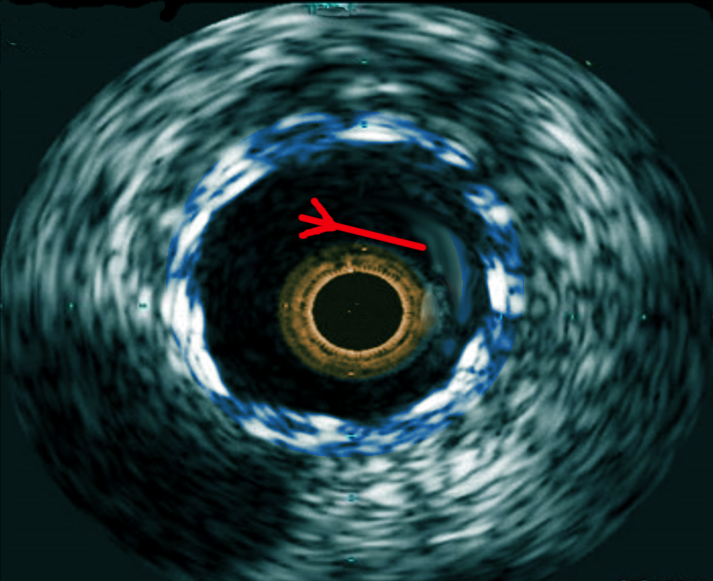[1]
Parviz Y,Shlofmitz E,Fall KN,Konigstein M,Maehara A,Jeremias A,Shlofmitz RA,Mintz GS,Ali ZA, Utility of intracoronary imaging in the cardiac catheterization laboratory: comprehensive evaluation with intravascular ultrasound and optical coherence tomography. British medical bulletin. 2018 Mar 1;
[PubMed PMID: 29360941]
[2]
Mintz GS,Popma JJ,Pichard AD,Kent KM,Satler LF,Chuang YC,Ditrano CJ,Leon MB, Patterns of calcification in coronary artery disease. A statistical analysis of intravascular ultrasound and coronary angiography in 1155 lesions. Circulation. 1995 Apr 1;
[PubMed PMID: 7895353]
[3]
Levine GN,Bates ER,Blankenship JC,Bailey SR,Bittl JA,Cercek B,Chambers CE,Ellis SG,Guyton RA,Hollenberg SM,Khot UN,Lange RA,Mauri L,Mehran R,Moussa ID,Mukherjee D,Nallamothu BK,Ting HH, 2011 ACCF/AHA/SCAI guideline for percutaneous coronary intervention: a report of the American College of Cardiology Foundation/American Heart Association Task Force on Practice Guidelines and the Society for Cardiovascular Angiography and Interventions. Catheterization and cardiovascular interventions : official journal of the Society for Cardiac Angiography
[PubMed PMID: 22065485]
Level 1 (high-level) evidence
[4]
Neumann FJ,Sousa-Uva M,Ahlsson A,Alfonso F,Banning AP,Benedetto U,Byrne RA,Collet JP,Falk V,Head SJ,Jüni P,Kastrati A,Koller A,Kristensen SD,Niebauer J,Richter DJ,Seferovic PM,Sibbing D,Stefanini GG,Windecker S,Yadav R,Zembala MO, 2018 ESC/EACTS Guidelines on myocardial revascularization. European heart journal. 2018 Aug 25;
[PubMed PMID: 30165437]
[5]
Garcìa-Garcìa HM,Gogas BD,Serruys PW,Bruining N, IVUS-based imaging modalities for tissue characterization: similarities and differences. The international journal of cardiovascular imaging. 2011 Feb;
[PubMed PMID: 21327914]
[6]
Song HG,Kang SJ,Ahn JM,Kim WJ,Lee JY,Park DW,Lee SW,Kim YH,Lee CW,Park SW,Park SJ, Intravascular ultrasound assessment of optimal stent area to prevent in-stent restenosis after zotarolimus-, everolimus-, and sirolimus-eluting stent implantation. Catheterization and cardiovascular interventions : official journal of the Society for Cardiac Angiography
[PubMed PMID: 22815193]
[7]
Hausmann D,Erbel R,Alibelli-Chemarin MJ,Boksch W,Caracciolo E,Cohn JM,Culp SC,Daniel WG,De Scheerder I,DiMario C, The safety of intracoronary ultrasound. A multicenter survey of 2207 examinations. Circulation. 1995 Feb 1;
[PubMed PMID: 7828285]
Level 3 (low-level) evidence
[8]
Witzenbichler B,Maehara A,Weisz G,Neumann FJ,Rinaldi MJ,Metzger DC,Henry TD,Cox DA,Duffy PL,Brodie BR,Stuckey TD,Mazzaferri EL Jr,Xu K,Parise H,Mehran R,Mintz GS,Stone GW, Relationship between intravascular ultrasound guidance and clinical outcomes after drug-eluting stents: the assessment of dual antiplatelet therapy with drug-eluting stents (ADAPT-DES) study. Circulation. 2014 Jan 28;
[PubMed PMID: 24281330]
Level 2 (mid-level) evidence
[9]
Zhang J,Gao X,Kan J,Ge Z,Han L,Lu S,Tian N,Lin S,Lu Q,Wu X,Li Q,Liu Z,Chen Y,Qian X,Wang J,Chai D,Chen C,Li X,Gogas BD,Pan T,Shan S,Ye F,Chen SL, Intravascular Ultrasound Versus Angiography-Guided Drug-Eluting Stent Implantation: The ULTIMATE Trial. Journal of the American College of Cardiology. 2018 Dec 18;
[PubMed PMID: 30261237]
Level 2 (mid-level) evidence
[10]
Hong SJ,Kim BK,Shin DH,Nam CM,Kim JS,Ko YG,Choi D,Kang TS,Kang WC,Her AY,Kim YH,Hur SH,Hong BK,Kwon H,Jang Y,Hong MK, Effect of Intravascular Ultrasound-Guided vs Angiography-Guided Everolimus-Eluting Stent Implantation: The IVUS-XPL Randomized Clinical Trial. JAMA. 2015 Nov 24;
[PubMed PMID: 26556051]
Level 1 (high-level) evidence
[11]
Mintz GS, Intravascular ultrasound and outcomes after drug-eluting stent implantation. Coronary artery disease. 2017 Jun;
[PubMed PMID: 28441172]
[12]
Steinvil A,Zhang YJ,Lee SY,Pang S,Waksman R,Chen SL,Garcia-Garcia HM, Intravascular ultrasound-guided drug-eluting stent implantation: An updated meta-analysis of randomized control trials and observational studies. International journal of cardiology. 2016 Aug 1;
[PubMed PMID: 27153138]
Level 1 (high-level) evidence
[13]
Mintz GS,Popma JJ,Pichard AD,Kent KM,Salter LF,Chuang YC,Griffin J,Leon MB, Intravascular ultrasound predictors of restenosis after percutaneous transcatheter coronary revascularization. Journal of the American College of Cardiology. 1996 Jun;
[PubMed PMID: 8636553]
[14]
Smilowitz NR,Mohananey D,Razzouk L,Weisz G,Slater JN, Impact and trends of intravascular imaging in diagnostic coronary angiography and percutaneous coronary intervention in inpatients in the United States. Catheterization and cardiovascular interventions : official journal of the Society for Cardiac Angiography
[PubMed PMID: 30019831]
[15]
Malik AH,Yandrapalli S,Aronow WS,Panza JA,Cooper HA, Intravascular ultrasound-guided stent implantation reduces cardiovascular mortality - Updated meta-analysis of randomized controlled trials. International journal of cardiology. 2019 Jul 10
[PubMed PMID: 31345647]
Level 1 (high-level) evidence

